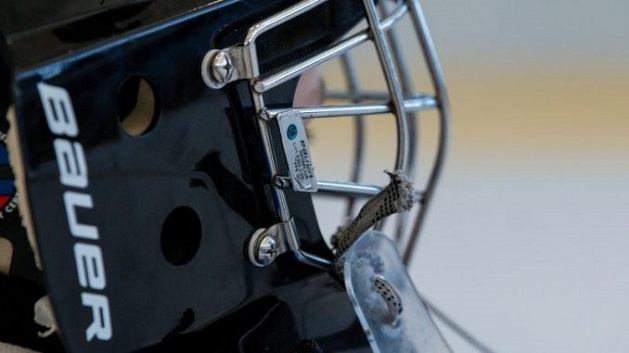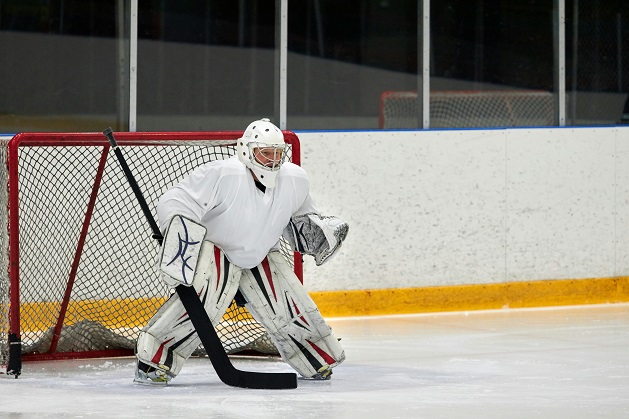Being a hockey goalie is a demanding role both physically and emotionally. It comes with the risk of pucks flying at you with a speed of up to 100mph, or in some cases you attacking them. That’s why this position has the most extensive gear. Without it, there’s a big chance you’ll get hit and injured.
Choosing reliable hockey goalie equipment is key to improving your defence skills and enjoying the game. Here’s a breakdown of the gear you need before you hit the ice, and some tips on how to make a well-informed purchase:
Goalie Mask

A mask is a crucial piece of gear for every hockey goalkeeper. There are various options, but the most important factor is proper fit. This means that the mask you choose should feel comfortable and stable. While these masks are slightly adjustable with a harness on the back, this feature is only for fine-tuning. It can’t fix a mask that doesn’t fit well, it can only adjust it.
You should also wear a cage on your masks to protect your face and eyes from ice, sticks and flying pucks. If you’re a beginner, opt for a straight bar cage. A more experienced goalie can use a cat eye cage, but this is not recommended for players still learning the fundamentals.
Chest Protector
Another vital piece of hockey goalie equipment is a chest protector. It’s especially crucial for beginners because pucks tend to hit your chest while learning to use your gloves and leg pads. A chest protector will shield your whole torso and arms from attacks, keeping your focus on the game.
Choosing the right model for your needs depends on your personal preference. But prioritising a snug, yet comfortable fit is key. The protector should also be long enough to cover your belly without leaving forearm gaps.
The style of goalkeeper you are also plays an important role. For example, if you’re a positional goalie who wants to play a blocking style, a bulkier protector is a great choice. On the other hand, a goalkeeper who relies on agility and athleticism will benefit from a more lightweight option.
Leg Pads

Leg pads offer protection for your legs and improve your ability to block pucks. They stretch from just above your toes to your thighs, covering your knees and supporting butterfly saves while helping you block more of the net.
It’s important to pick pads that fit snugly without restricting movement or knee rotation. Comfort is just as vital; the right pads can boost your confidence and performance. To find the best option, visit a hockey store and try different styles. This allows you to get properly sized and choose pads that suit your playing style and give you the protection you need.
Catch Gloves and Blockers
Catching gloves and blockers are key pieces of hockey goalie gear. The blocker, worn on your stick hand, consists of a foam board with a glove, built to deflect pucks. A good blocker offers balance, flexibility, and the right rebound control for your style.
On the other hand, the catching glove helps secure pucks. Catch gloves vary in break angles, 60, 75, or 90 degrees, which affects how you close the glove. Beginners often find a 75-degree break comfortable. You can also choose between a single-t or double-t pocket. Single-t pockets improve visibility, while double-t pockets provide more depth and stability for securing the puck.
Stick
A goalie hockey stick plays a critical role in your stance, control, and overall gameplay. Unlike player sticks, it has a widened paddle and is held in the blocker hand. Right-handed goalies (regular) hold the stick in their right hand, while left-handed goalies (full right) use their left hand.
Paddle length determines how the stick suits your stance. A stick that is too long creates gaps in the butterfly, while a shorter stick offers more control but requires you to bend lower to keep it flat on the ice. Most senior goalies benefit from a 25″ or 26″ paddle, with longer paddles reserved for taller players. The best way to size your stick is to check your blocker position while in the butterfly.
Skates
Goalie skates are designed for better mobility and protection compared to player skates. With flatter blades for quick post-to-post movement, they feature a lower cut and shorter tongue for flexibility in the crease. Some skates have a two-piece design, while newer models are one-piece.
When selecting the right size, go for one size down from your regular shoe size for a snug but comfortable fit. If you don’t have issues with foot cramping, a D width should suit you. For wider feet, consider E or EE widths for added comfort and ankle support.
Throat Protector
Goalies have two types of throat protection: the dangler and the neck guard. Both are mandatory at the junior level, and it’s also recommended that seniors wear both for added safety. The dangler is a Lexan plastic piece suspended from the goalie mask by skate laces, shielding the neck and throat.
It’s designed to break upon impact, providing essential protection during the game. The neck guard, or clavicle protector, is much more padded than the player version and is available as a separate piece or part of a padded shirt. While some goalies find them uncomfortable, a well-fitted neck guard becomes second nature.


